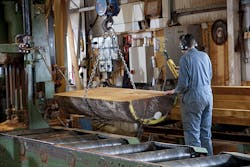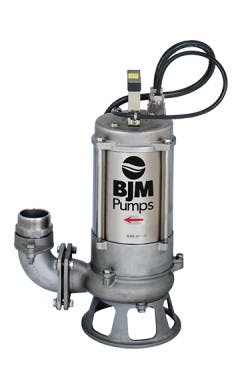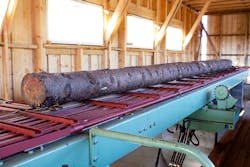Humans have used wood for construction for millenniums, but saw milling today is much different than when we first put axe to hand. It still starts with a tree, of course, but after that, it’s an entirely different matter.
A sawmill in Leola, Arkansas, population 501, recently improved its milling process for southern yellow pine trees using newly installed pumps. Pumps are important in sawmills, as they are in almost any processing-industry facility, but in sawmills their most important role comes later in the process.
Looking at the start of the process, mills today often use lasers to measure the logs, ensuring the maximum yield from each. In fact, nothing goes to waste. Bark is ground for landscaping, and sawdust is pressed into particle board or pellets for use in wood-burning stoves. Wood chips are ground and used for paper or as fuel to heat the drying kilns. Some sawmills use their waste in cogeneration facilities that power the operation and send extra energy to the grid.
Once cut to standard dimensions, the green wood is dried to prevent rotting, warping or splitting and to allow the wood to shrink. Wood can be dried various ways, but the Leola sawmill uses a kiln to dry it down to a moisture content of between 8 and 18 percent.
Unseasoned green
An Arkansas sawmill produces lumber from southern yellow pine trees. After milling, the green wood must be dried.
Next, the green wood is packaged and loaded onto kiln track cars. The packs are approximately 24-feet tall. Lumber sizes range from 2-by-4 inches up to 2-by-12 inches and are anywhere from 8 feet to 20 feet long. The kiln is about 125 feet long with two tracks moving lengthwise in opposite directions.
Over the course of 12 to 14 hours, wood is pushed through the kiln, entering one end as green wood and coming out the other as dry wood, explains Leola’s maintenance manager, Happy Stroud.
The kiln is heated by steam to temperatures up to 180ºF. As the lumber dries, condensation forms. The resulting acidic liquid wicks off the lumber and is collected in one of two pits at either end of the kiln.
This is where pumps come into play. The collected liquid needs to be pumped back to the powerhouse where it’s filtered for reuse. However, the condensation flowing into the pits carries with it bits of wood, bark and sand, which combine with the hot, acidic water to create an intense environment for any pump operation.
Until recently, the Leola mill used self-priming centrifugal pumps in its two kilns, but they clogged easily and were replaced about every two months, according James Reid, a sales representative for supplier Arkansas Industrial Machinery.
Issue resolving
Shredder pumps are used to clean out wood and other small debris that has fallen.
To resolve the pump issue, the supplier recommended BJM Fahrenheit stainless-steel shredder pumps. Stainless steel is designed to handle acidic water, and the pump’s motor withstands high temperatures. Additionally, the pump’s shredding action clears out pieces of wood or any other particles in the flow, rather than letting them build up in the bottom of
the pit.
The previous pumps sat outside the pit and had to pull the condensate up. This was a problem because debris collected in the pits. The elevated water temperature also caused issues.
"Hot liquid tends to flash off when you’re pulling it up the self-priming pipe," Morgan says.
Hot water flashes off at a faster rate because of the heat it already bears. If it flashes when put under a vacuum to pull it up a pipe, the pump loses prime and has to re-prime itself. It can never pull all the fluid out.
"The shredder pumps sit in the bottom of the pit and can push the liquid out instead of having to suck it up in a straw," he adds.
Seals & signals
In today’s modern saw mills, logs are carefully measured and then processed for the maximum yield of timber.
The shredder pump has two seals. If one fails, a control-panel alarm sounds. Given notification, the plant can repair the pump without breaking through the second seal. Pump failure is avoided.
"It improves the reliability of the equipment for the maintenance crew and for the mill," Morgan adds.
The pump’s non-clog impellers handle high volume and lift performance. All wear and wet parts such as impeller, wear-plate, oil housing, pump housing and inner pump top are made of Cast 316 stainless material. Elastomers such as O-rings, lip seals, and gaskets are made of FKM.
The Leola sawmill has found the new pumps reliable. Both Stoud and Reid report that they have not seen any issues so far, and Reid adds that afterward he has sold more of the Fahrenheit pumps to other paper mills that have work pits.
Mike Bjorkman is vice president of BJM Corp. and has more than 30 years of experience in the pump industry. He serves as director of marketing and IT for BJM Pumps LLC and All Test Pro LLC. He can be reached at 860-399-5937.



